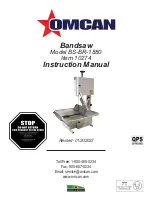
3
protection used for appropriate
conditions will reduce personal
injuries.
c) Prevent unintentional starting.
Ensure the switch is in the off
position before connecting to
power source and/ or battery
pack, picking up or carrying the
tool. Carrying power tools with your
finger on the switch or energizing
power tools that have the switch on
invites accidents.
d) Remove any adjusting key or
wrench before turning the power
tool on. A wrench or a key left
attached to a rotating part of the
power tool may result in personal
injury.
e) Do not overreach. Keep proper
footing and balance at all times.
This enables better control of the
power tool in unexpected situations.
f) Dress properly. Do not wear loose
clothing or jewelry. Keep your
hair, clothing and gloves away
from moving parts. Loose clothes,
jewelry or long hair can be caught in
moving parts.
g) If devices are provided for the
connection of dust extraction and
collection facilities, ensure these
are connected and properly used.
Use of dust collection can reduce
dustrelated hazards.
4) POWER TOOL USE AND CARE
a) Do not force the power tool. Use
the correct power tool for your
application. The correct power tool
will do the job better and safer at the
rate for which it was designed.
b) Do not use the power tool if the
switch does not turn it on and
off. Any power tool that cannot
be controlled with the switch is
dangerous and must be repaired.
c) Disconnect the plug from the
power source and/or the battery
pack from the power tool before
making any adjustments,
changing accessories, or storing
power tools. Such preventive safety
measures reduce the risk of starting
the power tool accidentally.
d) Store idle power tools out of
the reach of children and do not
allow persons unfamiliar with the
power tool or these instructions
to operate the power tool. Power
tools are dangerous in the hands of
untrained users.
e) Maintain power tools. Check
for misalignment or binding of
moving parts, breakage of parts
and any other condition that may
affect the power tool’s operation.
If damaged, have the power
tool repaired before use. Many
accidents are caused by poorly
maintained power tools.
f) Keep cutting tools sharp and
clean. Properly maintained cutting
tools with sharp cutting edges are
less likely to bind and are easier to
control.
g) Use the power tool, accessories
and tool bits, etc. in accordance
with these instructions, taking
into account the working
conditions and the work to be
performed. Use of the power tool
for operations different from those
intended could result in a hazardous
situation.
5) SERVICE
a) Have your power tool serviced by
a qualified repair person using
only identical replacement parts.
This will ensure that the safety of the
power tool is maintained.
ADDITIONAL SAFETY RULES
FOR MITER SAWS
Do not allow familiarity
(gained from frequent use of your
saw) to replace safety rules. Always
remember that a careless fraction of
a second is sufficient to inflict severe
injury.
• DO NOT OPERATE THIS MACHINE
until it is completely assembled and
installed according to the instructions.
A machine incorrectly assembled can
cause serious injury.
• OBTAIN ADVICE from your supervisor,
instructor, or another qualified person if
you are not thoroughly familiar with the
operation of this machine. Knowledge
is safety.
• STABILITY. Make sure the miter saw is
placed on a secure supporting surface
and does not slip or move during use.
• FOLLOW ALL WIRING CODES and
recommended electrical connections
to prevent shock or electrocution.
Protect electric supply line with at least
a 15 ampere time-delay fuse or
a circuit breaker.
• MAKE CERTAIN the blade rotates in
the correct direction. The teeth on the
blade should point in the direction of
rotation as marked on the saw.
WARNING
!




































